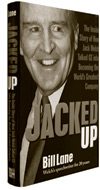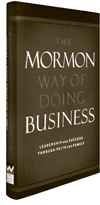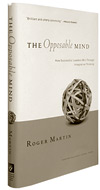Books in Brief
The mensch of corporate turnarounds, the earthy language of “Neutron Jack,” the work–life balance of Mormon executives, and the cognition of effective leaders.
(originally published by Booz & Company)|
The Turnaround Kid: What I Learned Rescuing America’s Most Troubled Companies By Steve Miller HarperCollins, 2008, 272 pages
CEOs rarely tell you anything about the roles that their spouses play in their lives and the contributions spouses make toward their success, and they never tell you about their first sexual encounter. Delphi Corporation Chairman and CEO Robert S. “Steve” Miller does all these things in The Turnaround Kid: What I Learned Rescuing America’s Most Troubled Companies. Throughout the book, he makes it clear that his wife, Maggie, who died in 2006, was his partner in business — as a truth teller, evaluator of people, and ethical advisor — as well as in marriage. Miller sees his series of high-profile jobs as being held by “us” rather than “me.” Steve Miller was born to a wealthy professional family in Oregon that had amassed its fortune over three generations in the lumber industry. With a law degree from Harvard and an MBA from Stanford, he served his apprenticeship in the Ford Motor Company during the “whiz-kid” era of the 1960s. After extensive experience with burgeoning responsibilities in the Ford “Foreign Legion” in South America and the Asia-Pacific regions, he was drafted by Lee Iacocca and Gerry Greenwald (both ex-Ford executives) into the turnaround of Chrysler. He joined this 24/7 cause without even asking what he would be paid and reveled in the freedom from bureaucracy that corporate crises can bring. He honed his skills in arduous negotiations to get 400 lenders to sign off on Chrysler’s complex deal, learning to listen, explain, and treat everyone equally. In the process he discovered that turnaround specialist was the role that suited him best, allowing him to fuse work and passion while leaving the challenge of achieving a work–life balance to ever-resourceful Maggie. With his reputation made by the success of the Chrysler rescue, Miller went on to a career of saving and rebuilding big enterprises in both the private and public sectors. The companies listed on his resume are some of North America’s best-known corporate basket cases — Olympia & York Developments, Morrison Knudsen, Federal-Mogul, Waste Management Inc., Bethlehem Steel, and, most recently, Delphi Corporation, the ill-fated parts spin-off from General Motors. (He also helped rescue the Detroit Symphony Orchestra.) Throughout these challenges Miller comes across as, to use a Yiddish term, a real mensch: the kind of guy who makes his own phone calls, meets with people in their offices rather than his, and eats in the company cafeteria, all in the interest of saving time, conveying sincerity, and building rapport. The take-home message of this memoir is that there are talented people in troubled organizations who often have all the answers but usually are not focused on the right questions. The role of the turnaround manager is to understand and pose the key questions while freeing up the communication webs both inside and outside the organization. Steve Miller reaches for resources wherever they are to be found. For example, he relies heavily on his executive assistants to tell him about what’s really happening. If, as research suggests, leadership skills are best taught by tough assignments, influential bosses, and hardships, Steve Miller’s story is an excellent illustration of that learning process at work.
|
|
Jacked Up: The Inside Story of How Jack Welch Talked GE into Becoming the World’s Greatest Company By Bill Lane McGraw-Hill, 2008, 336 pages
Effective executives use both layers, but you would never know it from their writings, where they are usually on their best behavior and looking for resources and support rather than commitment. Bill Lane, Jack Welch’s speechwriter for 20 years, has done readers a service by revealing the plain, rough-spoken, Anglo-Saxon world that General Electric’s best-known CEO created. In Jacked Up: The Inside Story of How Jack Welch Talked GE into Becoming the World’s Greatest Company, he tells the tale of his relationship with Welch and how Lane helped Welch talk a great company into becoming even better. By the time Welch became CEO in 1981, he believed GE had become a place with too many high-flown visions, too much abstract planning, and too many “bullshit meetings.” The rhetorical component of his early “Neutron Jack” era was to do away with the vision “extravaganzas” in favor of “success stories with messages attached.” It is clear that he was ably assisted by Lane, whose combat experience in Vietnam stood him in good stead as the duo “cut through the crap.” The once hushed halls of the thickly carpeted GE executive suite became more like a war zone, with profanity ricocheting off the mahogany walls as vigorous disputes broke out between the mercurial Welch and his like-minded colleagues on one side and their subordinates on the other. It’s no surprise to learn that much of GE’s executive communication takes the form of presentations, but the extent of the presentation culture and the intensity with which presentations are prepared and rehearsed are eye-openers. Lane takes the opportunity to give the readers a number of pointers on how to create and deliver their own presentations: Keep them short, interesting, forthright, and candid, with a ruthless assessment of what worked and what didn’t. One question is, of course, if all the bosses right up to the top don’t practice these values, how realistic is it for you to do so? Lane tries to follow his own prescriptions in the book — with mixed results. The chapters are short, but there are 82 of them. At times the book rambles on and one wishes that the messages were more condensed, but ultimately the war stories about the dynamic Jack Welch are strong enough to carry this load.
|
|
The Mormon Way of Doing Business: Leadership and Success through Faith and Family By Jeff Benedict Warner Business Books, 2007, 256 pages
The most striking features of these men are their focus, discipline, and persistence; it is further striking how well the Mormon beliefs and practices have prepared them for leadership roles. Faith and family are the warp and weft of the Mormon existence: All members must tithe to the church and, because there is no professional ministry, they have to perform the church’s many functions without pay. All young men are encouraged to start saving as teen-agers to go on a two-year mission to preach the gospel of the Latter-Day Saints (LDS) in a foreign country and to learn the local language before going there. On their return, their ecclesiastical work supplies them with practical experience, role models, and mentors. Women may also go on missions and are encouraged to get college degrees. In the Mormon church, the central role of women is still that of mother. Unlike so much of Western society, which pays only lip service to work–life balance, the LDS community has made such balance a pillar of daily life. To pull it off takes organization — focus, discipline, and practice. The weekend is for faith and family: Mormon businessmen will not work on Sundays and avoid working on Saturdays and weeknights. This means that they have to make productive use of every available moment. When Clark was a professor at Harvard Business School, he would get into his office by 7 a.m. and talk to no one before noon. What any businessperson wouldn’t give for five uninterrupted hours, even just one day a week. In their relentless focus on their priorities and their continual, conscious integration of faith, family, and work, the Mormons are reminiscent of the early Quakers and other nonconformists, small faith-based groups that played such a central role in the first Industrial Revolution. Benedict’s book makes us think they could easily play a similar role in any future economic or social revolutions.
|
|
The Opposable Mind: How Successful Leaders Win through Integrative Thinking By Roger L. Martin Harvard Business School Press, 2007, 222 pages
Experts in any field where the skills are tacit rather than explicit are notoriously inept at accounting for their success. It is up to researchers to identify the patterns and tease out the components. The holy grail is to make the expert’s methods explicit and teachable, and this is Martin’s goal. But it requires him to make two questionable assumptions that, in fact, are common enough to provoke much of the criticism of business schools. The first is that effective action is, or should be, preceded by a conscious, context-independent process called “thinking”; the second is that training in this process can improve performance. Together, these two assumptions lead to an uncomfortable disconnect between theory and practice as the writer alternates between abstract conceptual frameworks and war stories from the field. For example, the elements of the thinking process are described as four stages, Salience, Causality, Architecture, and Resolution. According to Martin, it is a sequence that conventional thinkers negotiate in a narrow, linear fashion, whereas integrative thinkers make continual recursions, keeping their options open while searching for broader solutions. This may be so, but it is hard to see how the author derives this from the data. In addition, Martin’s research method will not pass scientific scrutiny. He studies only successes, and there is no consideration of counterexamples, either of integrative thinkers who failed or of conventional thinkers who succeeded. It seems unlikely, for example, that either Jeff Skilling, former chief executive of Enron, or fallen press baron Conrad Black failed because of their inability to think integratively. John Dewey once wrote, “No thought, no idea, can possibly be conveyed as an idea from one person to another.” That may sound like a bleak point of view and one that business schools are unlikely to embrace, but it underlines the fact that the price of “context independence” is abstraction. In an effort to escape the use of abstractions when teaching business, there is a significant move toward the use of simulations — mini-experiences through which students learn without being formally taught. Concepts, if they are used at all, come up as interpretive frameworks rather than as guides to action. When we cannot reduce the tacit knowledge of experts to explicit, teachable concepts, the best we can do is understand how their practice and experience contributed to their success. We may then be in a position to replicate those experiences for others to learn from. The book’s stories of leaders such as A.G. Lafley, CEO of Procter & Gamble, are interesting ones, but they would have been made more compelling if Martin had distilled the essence of their experiences rather than laid on what feels at times like a Procrustean conceptual framework. Practice may have once again trumped theory. |
Reprint No. 08212
Author profile:
David K. Hurst is a contributing editor at strategy+business. His writing has also appeared in the Harvard Business Review, the Financial Times, and other leading business publications. Hurst is the author of Crisis and Renewal: Meeting the Challenge of Organizational Change (Harvard Business School Press, 2002).



 English is a two-tier language, with a lofty Latinate vocabulary overlaid on an earthy, Anglo-Saxon base. For a manager, each of these layers of language has an essential role to play. When communicating “up” and requesting resources and support, the erudite, Latin-based layer lends an air of conceptual sophistication. When talking “down” for prompt commitment and action, only the Germanic layer will do.
English is a two-tier language, with a lofty Latinate vocabulary overlaid on an earthy, Anglo-Saxon base. For a manager, each of these layers of language has an essential role to play. When communicating “up” and requesting resources and support, the erudite, Latin-based layer lends an air of conceptual sophistication. When talking “down” for prompt commitment and action, only the Germanic layer will do.  Mitt Romney’s run for the 2008 Republican presidential nomination brought Mormons and their beliefs closer public scrutiny than ever before. In The Mormon Way of Doing Business: Leadership and Success through Faith and Family, Jeff Benedict, himself a Mormon, has given us a timely insight into the style and habits of leading Mormon businessmen. His subjects are David Neeleman, CEO of JetBlue; Dave Checketts, former president of Madison Square Garden Corporation; Kevin Rollins, former chief executive of Dell; James Quigley, CEO of Deloitte Touche Tohmatsu; Gary Crittenden, former CFO of American Express; Rod Hawes, founder of Life Re Corporation; and professor Clayton Christensen and former dean Kim Clark of Harvard Business School (Clark is currently president of Brigham Young University–Idaho).
Mitt Romney’s run for the 2008 Republican presidential nomination brought Mormons and their beliefs closer public scrutiny than ever before. In The Mormon Way of Doing Business: Leadership and Success through Faith and Family, Jeff Benedict, himself a Mormon, has given us a timely insight into the style and habits of leading Mormon businessmen. His subjects are David Neeleman, CEO of JetBlue; Dave Checketts, former president of Madison Square Garden Corporation; Kevin Rollins, former chief executive of Dell; James Quigley, CEO of Deloitte Touche Tohmatsu; Gary Crittenden, former CFO of American Express; Rod Hawes, founder of Life Re Corporation; and professor Clayton Christensen and former dean Kim Clark of Harvard Business School (Clark is currently president of Brigham Young University–Idaho). Ever since the publication of In Search of Excellence in 1982, the competition between theory and practice for the attention of management readers has been lopsided, with practice clearly far ahead. In The Opposable Mind: How Successful Leaders Win through Integrative Thinking, Roger L. Martin, former management consultant and dean of the Rotman School of Management at the University of Toronto, adds his considerable weight to the other side of the struggle. In his view, management action is too dependent on context to be helpful as a guide to others, and transferable learning comes from understanding how effective leaders think, rather than from understanding what they do. He uses the gleanings from more than 50 interviews with successful leaders to argue that they share a capacity for a “cognitive discipline” he calls integrative thinking. The opposable mind, he suggests, can be used to grasp complex situations and is an antidote to the either–or decision making characteristic of conventional thinking.
Ever since the publication of In Search of Excellence in 1982, the competition between theory and practice for the attention of management readers has been lopsided, with practice clearly far ahead. In The Opposable Mind: How Successful Leaders Win through Integrative Thinking, Roger L. Martin, former management consultant and dean of the Rotman School of Management at the University of Toronto, adds his considerable weight to the other side of the struggle. In his view, management action is too dependent on context to be helpful as a guide to others, and transferable learning comes from understanding how effective leaders think, rather than from understanding what they do. He uses the gleanings from more than 50 interviews with successful leaders to argue that they share a capacity for a “cognitive discipline” he calls integrative thinking. The opposable mind, he suggests, can be used to grasp complex situations and is an antidote to the either–or decision making characteristic of conventional thinking.